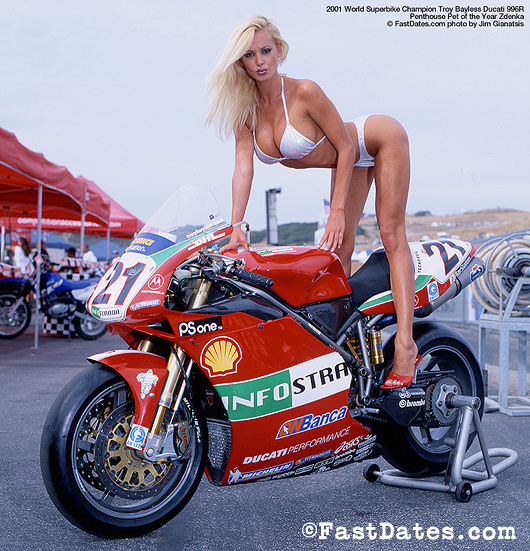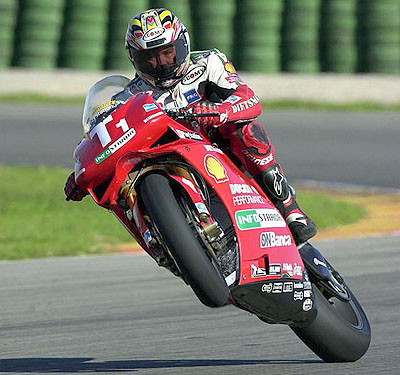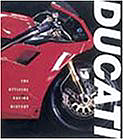Inside
Troy Bayless' World Championship
winning 2001 Ducati 996R
The new 2002 superbikes previewed Here

Troy Bayless' Championship winning 996R and Penthouse Pet Zdenka
are featured in Members Corner and in
the 2003 Fast Dates Calendar. It is illegal
to download or copy these images to other websites.
The
new Testastretta Superbike is
just at the start of it's
development cycle -with a lot more power to come!
TESTASTRETTA
- RACE DEVELOPED (1/9)
More power is good…just
heap it on and it will all come good in the end. That's the way
it goes in racing, isn't it? Not at Ducati. At the start of the
year, chief engineer Corrado Cecchinelli said the new Testastretta
engine used in the 996R was only at 50 per cent of its development
capacity and predicted the factory would find another 20bhp on top
of the 174bhp it had unleashed before the start of the year. But
that hasn't happened - Cecchinelli revealed why. Peak power is exactly
the same as it was at the start of the year - though in the extremely
capable hands of Troy Bayliss it has been leading the championship
since the third round of the year in Australia. That's because Ducati
is playing safe. The aim is to get more power and performance in
small stages without hitting reliability or Ducati's legendary user-friendliness.
TESTASTRETTA
- RACE DEVELOPED (2/9)
Testastretta means "narrow head," but this explanation
doesn’t describe how different the classic Italian V-twin
is to the engine that can trace its history all the way back to
the 851 motor from 1986. It does not mean the head of the engine
is narrower - instead, the angle between the inlet and exhaust
valves has been reduced. The advantage is a more compact combustion
chamber, letting the fuel/air mixture burn more efficiently. |

2001 World
Champion Troy Bayless wheelies the 996R during early season testing,
both of which went on to secure both the Rider's and Manufacturer's
championship titles. ©FastDates.com |
When you consider
the race version is already putting out 174bhp at the crank and revs
to 13,000rpm, 500rpm higher than the 2000 bike, it's clear some pretty
big internal changes have been made to the new
motor. There had to be, as the old 996SPS had reached the end of its
development. The main change - and the one that accounts for the more
metallic, higher-pitched boom the bike makes compared to the 2000-spec
996s - is that the bore has been increased and the stroke shortened,
which means that while the pistons are larger, they move up and down
over a shorter distance, allowing the engine to rev higher without the
risk of mechanical failures.
TESTASTRETTA
- RACE DEVELOPED (3/9)
The race bike also makes extensive use of titanium components, which
helps lighten the new motor by 5kg (11lb). Not only does this help
get the new 996R as near to the 162kg (356lb) minimum WSB weight limit
as Ducati ever has, it means moving the parts takes less effort and
there is less stress on them.
Cecchinelli said:
"The development of our engines is continuous - once we find
out one cylinder head has reached the end of the line we will develop
another one that can do a better job. The same goes for every component
in the engine. When you realise the 996SPS puts out 123 bhp after
years of development and the new engine is already putting out 134bhp
in standard form, you can see that there is still a long way to go."
TESTASTRETTA - RACE DEVELOPED (4/9)
That's why, despite a shorter stroke which would tend to suggest considerably
more rpm, the engine is only revving 500rpm higher than the old one.
After several thousand miles of testing, the team knows the engine
can handle that. The next step is to add another 500rpm and make sure
all the internal components can take the strain before moving on.
Cecchinelli said:
"This is a much better bike than last year and we are working
very closely with Magnetti-Marelli to tune the fuel injection to make
sure the bike is nice to ride with no problems on part throttle openings."
The fuel injection
system is a similar concept to the single injector system used last
year, but has been further enhanced by Marelli to provide as much
set-up and fine tuning to suit each track as possible. The Testastretta's
slightly smaller cylinder heads allow Ducati to fit a deeper base
to the airbox, to get the biggest volume of air possible into the
engine.
ESTASTRETTA
- RACE DEVELOPED (5/9)
The big-bore 60mm exhausts are 4mm up in diameter compared with last
year's race bike to cope with the increased airflow through the engine.
The fuel injection system is one of the key areas Ducati has been
working on this season to find a set-up that not only suits the different
styles of the three riders - Bayliss, Ben Bostrom and Ruben Xaus -
but doesn't make it more difficult to ride.
Cecchinelli said:
"The main work this year has been making sure the fuel injection
and ignition are working as well as they can. This has been 90 per
cent of the job we have had to do rather than try to find more power.
There has been some work this year on camshafts which has given a
lot more power, but during testing we found the bike was too difficult
to ride so we went back to the old ones. Once we knew the bike was
working well, we were anxious to make sure the reliability was there.
That has meant stronger conrods, pistons and cams to make sure nothing
will break during races."
TESTASTRETTA
- RACE DEVELOPED (6/9)
Previous Ducati race bikes ran hot, so the 996R has completely revised
radiators to increase the flow of coolant. While Ducati has been tweaking
the engine, it has also been working on the rest of the 996R. The
Ohlins suspension has been uprated for this year, with the 42mm upside-down
forks offering more adjustments than ever before. The multitude of
different springs, oils and rebound and compression damping changes
available mean it's rare a set-up can't be found to suit a track.
TESTASTRETTA
- RACE DEVELOPED (7/9)
The rear shock has been altered, too. A larger body reservoir helps
control the rising-rate linkage more effectively. These linkages both
raise and lower the rear of the bike and control the rising rate of
the suspension. The high degree of adjustability is also vital since
every gearing change not only alters the wheelbase, but also alters
the rear ride height due to the eccentric chain adjustment system.
Riders have a massive choice of linkages to suit the different tracks
and their riding styles - each has a billet aluminium pushrod especially
made. Bostrom likes his bike loose and high at the back so he can
slide it into and out of the turns. Bayliss likes a more controlled
approach and has a stiffer set-up.
TESTASTRETTA
- RACE DEVELOPED (8/9)
Brembo has also supplied the latest 320mm ventilated front discs,
which are gripped by radially-mounted calipers. These have the advantage
of reducing flex and heat build-up in the pads and improving response.
The Brembo technicians have coated the outside edge of the discs with
heat-reactive paint that allows them to see what temperature the discs
have reached and how well they have worked. This shows Ducati is being
as cautious with the braking as it is with the engine, keen not to
ruin the overall package by making hasty changes.
TESTASTRETTA
- RACE DEVELOPED (9/9)
Championship winner Bayliss said: "There's so much about the
new bike that is so similar to the old one that you can still feel
the family resemblance. But it's in the key areas of power delivery
that the bike is so strong. Bottom-end grunt is simply amazing - the
instant you crack the throttle it rockets out of the corners so much
better than the old bike."
NEW
TESTASTRETTA 998R- New Race Homologation Model for 2002! (9/18)
At the Milan International Motorcycle Show in September 2001, Ducati
pulls another ace out of its sleeve with a newly revised 998R model
for the 2002 year, effectively the current 996R but with an even shorter
stroke engine Testastretta motor at 104mm bore x 85.8mm stroke displacing
999cc and stock compression raised from 11.4 to 12.3:1 and rated at
139 horsepower with street tuning. The even shorter stroke engine
will allow even higher RPMs and proportionally more horsepower, possibly
as much as 220 hp when fully developed, and certainly more than present
race tires can handle. This new short stroke Testastratta should correctly
be called a 999R to differenciate it from the 998 longer stroke models,
but just like the 996R, Ducati has a history of confusing us this
way to tie-in the race bikes to the current streetbikes, possibly
for marketing reasons.
The stock
DUCATI 996R CHASSIS:
• Frame
Tubular steel trellis frame Wheelbase 1410 mm with adjustable Rake
23.5 - 24.5 deg.
• Front suspension Ohlins with TiN upside-down fork fully adjustable
Front wheel travel 120 mm
• Front wheel Marchesini 5-spoke light alloy 3.50 x 17 Front
tyre 120/70 ZR 17
• Rear suspension Ohlins progressive linkage with adjustable
monoshock Rear wheel travel 130 mm
• Rear wheel Marchesini 5-spoke light alloy, 5.50 x 17 Rear
tyre 190/50 ZR 17
• Front brake 2 x 320 mm semi-floating discs, 4-piston 4-pads
caliper
• Rear brake 220 mm disc, 2-piston caliper
• Fuel capacity 17 l (4 l reserve). Ducati weight 185 kg / 407
lbs. Seat height 790 mm
• Instruments: Speedometer, rev counter, indicators for high
beam, turn signals, warning light for low oil pressure, fuel level,
warning light for neutral, water temperature.
Official TECHNICAL
SPECIFICATIONS -
2001 DUCATI 996R FACTORY 01
Team Ducait Corse World Championship Superbike
Engine: Testastretta
998cc Type: four stroke "L" twin
Capacity: 998cc Bore x stroke: 100mm x 63.5mm
Brake horsepower: 175HP at 12000 r.p.m
Timing system: desmo DOHC Valves: 4 per cylinder
Carburation: two 60mm single-injector throttle bodies
Fuel system: Electronic injection system, MF3S module
Ignition: Magneti Marelli electronic ignition
Injector: Magneti Marelli IWF1, one per cylinder
Lubrification: gear oil pump, with oil cooler
Final drive:
Regina chain
Top speed: 300km/h
Chassis Specifications
Frame: steel tube trestle
Front suspension: 42 mm upside-down ÷Ohlins fork
Rear suspension: Single-sided magnesium swingarm, with ÷hlins shock
absorber
Brakes Make: Brembo Front: two 320mm Dia. or 290mm Dia., stainless
steel floating discs.
Rear: 200mm Dia. lightweight disc or 218mm Dia. vented disc. Fluid:
Shell Advance Brake DOT 5.1
Trasmission Gearbox: 6-speed Clutch: dry multiplate cluch
Tyres Make: Michelin: Troy Bayliss, Ruben Xaus., Dunlop: Ben Bostrom
Front: 12/60-17"or 12/60-420 - 16,5" Rear: 18/60-17"
or 19/67-420 - 16,5"
Overall dimensions Length: 2045mm Width: 680mm
Dry weight: 162Kg (356 lbs.), with oil and water
Wheelbase: 1425mm Fuel tank capacity: 24L
|








